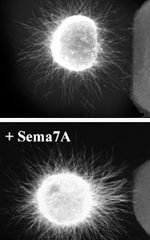Articles and reports from the Life Sciences and chemistry area deal with applied and basic research into modern biology, chemistry and human medicine.
Valuable information can be found on a range of life sciences fields including bacteriology, biochemistry, bionics, bioinformatics, biophysics, biotechnology, genetics, geobotany, human biology, marine biology, microbiology, molecular biology, cellular biology, zoology, bioinorganic chemistry, microchemistry and environmental chemistry.

The scientist from the Institute of Plants and Animals Ecology, Russian Academy of Sciences (Ural Branch), has made a description of the giant dear remains, found in the Ural, and has determined their age. Giant deer Megaloceros giganteus originated as a species in the preglacial epoch, lived through the glaciation period and died out about 8-9 thousand years ago after the climate had become warmer. The remains will help to investigate how the giant dear lived and why this species disappeared. The r

For decades, scientists have hunted for signals that guide nerve cells’ tentacle-like axons, hoping to understand how these cell tips reach out to distant targets. It’s knowledge that might one day help researchers learn how to rebuild nerves lost to spinal cord injuries or diseases like Huntington’s.
Now, a Johns Hopkins team studying a family of proteins best known for repelling axons and inhibiting their growth reports finding one member that unexpectedly promotes axon growth ins

Disrupted-In-Schizophrenia 1 (DISC1) was identified as a novel gene disrupted by a (1;11)(q42.1;q14.3) translocation that segregated with schizophrenia in a Scottish family. Predicted DISC1 product has no significant homology to other known proteins. Here, Dr. Katayama and colleagues in Osaka, Japan, demonstrated the existence of DISC1 protein and identified fasciculation and elongation protein zeta-1 (FEZ1) as an interacting partner of DISC1 by a yeast two-hybrid study. FEZ1 and its nematode homolog

Chemists at Rice University have identified a chemical process for cutting carbon nanotubes into short segments. The new process yields nanotubes that are suitable for a variety of applications, including biomedical sensors small enough to migrate through cells without triggering immune reactions.
The chemical cutting process involves fluorinating the nanotubes, essentially attaching thousands of fluorine atoms to their sides, and then heating the fluoronanotubes to about 1,000 Celsi

Researchers at the University of California, San Diego (UCSD) School of Medicine have identified a previously unknown component of the body’s cellular garbage disposal called the ubiquitin system, which is responsible for regulation of cell function by removal of abnormal and unneeded proteins.
Published in the July 8, 2003 issue of Proceedings of the National Academy of Sciences, the study provides the first description of a molecule called GAIP interacting protein N terminus (GIPN)

Virginia Tech wood scientists hope that their vacuum-drying project will benefit wood pallet and container manufacturers and hardwood sawmill businesses across the nation.
“The vacuum controlling system eliminates the need for a heating system, saves energy, and does not release ozone-depleting chemicals into the earth’s atmosphere,” says Zhangjjng Chen, one the researchers working on the project at the Center for Unit Load and Design in the wood science and forest products depa